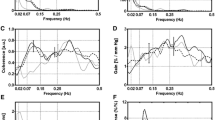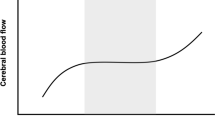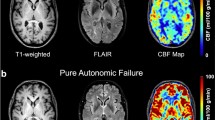Abstract.
In familial dysautonomia (FD), cerebral autoregulation (CA) must adjust cerebral blood flow to extreme and rapid fluctuations in systemic blood pressure. Compromised CA during systemic blood pressure (BP) fluctuations might contribute to central autonomic dysfunction in FD.
To evaluate CA during rapid BP changes, we monitored heart rate (HR), radial artery BP and middle cerebral artery blood flow velocity (CBFV), using transcranial Doppler sonography, in eight FD patients and twelve age-matched controls in supine position at baseline and during a Valsalva maneuver (VM, 40 mmHg expiratory pressure for 15 seconds). The best of four VM recordings was analyzed. We calculated two autoregulation parameters. CAII reflects BP related autoregulatory CBFV increase in late phase II of VM. CAII = [(CBFVII late-CBFVII early)/CBFVII early]/[(BPII late-BPII early)/BPII early]. CAIV reflects BP and HR related autoregulatory CBFV increase in phase IV of VM. CAIV = (CBFVIV/CBFVI)/(BPIV/BPI)/(HRIV/HRI). Baseline systemic BP, but not CBFV, was higher in the patients than the controls. During VM, both groups had similar CBFV and BP values, but CAIV and especially CAII were significantly lower in the patients than the controls. We have documented that FD patients maintain stable CBFV during rapid BP fluctuations associated with early and late phase II and phase IV of VM suggesting that small intracerebral vessels of FD patients are less responsive to rapid systemic blood pressure fluctuations. To compensate for decreased sympathetic vascular innervation, we propose that FD patients may alter the myogenic component of CA by vessel wall thickening resulting in increased rigidity of intracerebral resistance vessels. The resulting vasoconstriction would allow maintenance of normal baseline CBFV in spite of chronic recumbent hypertension.
Similar content being viewed by others
Author information
Authors and Affiliations
Additional information
Received: 31 August 2001, Accepted: 24 April 2002
Correspondence to M. J. Hilz, M. D., Ph. D.
Rights and permissions
About this article
Cite this article
Hilz, M., Axelrod, F., Steingrueber, M. et al. Valsalva maneuver suggests increased rigidity of cerebral resistance vessels in familial dysautonomia. Clin Auton Res 12, 385–392 (2002). https://doi.org/10.1007/s10286-002-0027-9
Issue Date:
DOI: https://doi.org/10.1007/s10286-002-0027-9




